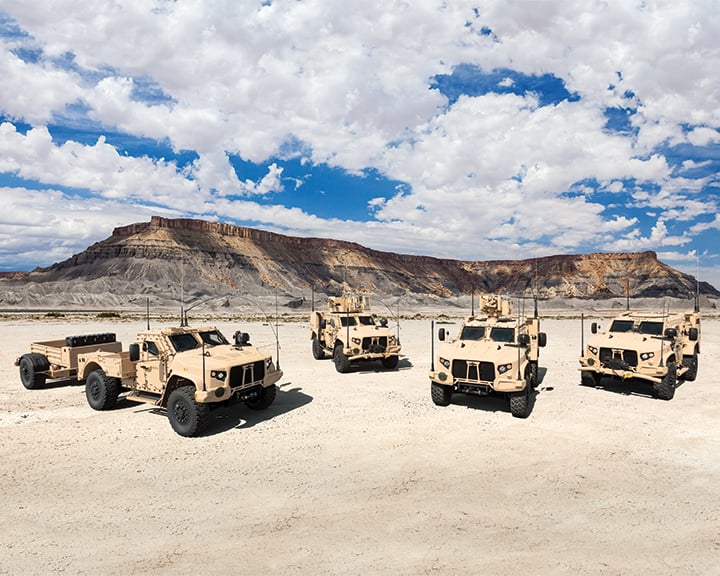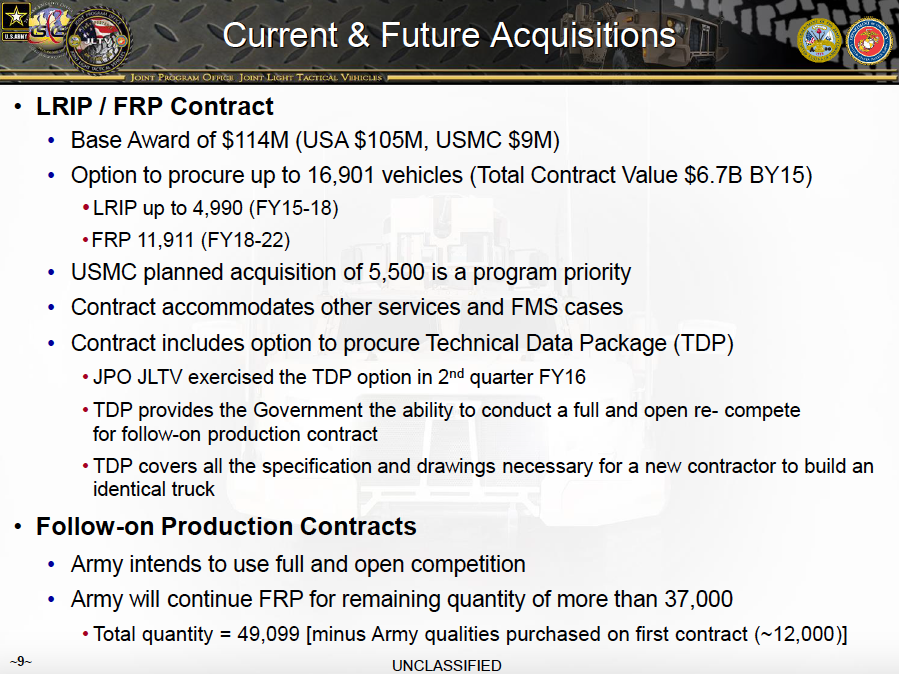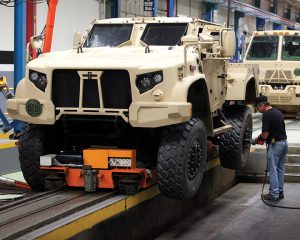
The four official JLTV variants.
NATIONAL PRESS CLUB: The Army is about to blow the Joint Light Tactical Vehicle program wide open. In public remarks today by Army Secretary Ryan McCarthy and a notice to industry quietly updated online, the service made clear it is reopening two multi-billion-dollar questions that were supposedly settled by the 2015 award of the hotly contested JLTV contract to Oshkosh: How many 4×4 offroad trucks does the Army really need, and who should build them?

Army Secretary Ryan McCarthy
Originally intended to replace the underarmored Humvee and the lumbering MRAP with a nimble and well-protected vehicle, the JLTV has suffered major cuts in the last two budgets. At the same time, each budget document also insists the Army hasn’t changed the total number it plans to buy. It’s just spreading that buy out over a longer term. But McCarthy made clear today the total number may change.
“When you look at our vehicle portfolio, we’ve got about 48, 49 thousand Humvees; program of record for JLTV is about 49,000 JLTVs. And Infantry [Squad] Vehicles, we’re going to have about a thousand of those,” McCarthy said at a National Press Club luncheon. “That’s a breathtaking amount of vehicles, even for an organization as big as us. What we’ve asked for is a study of just how many do we need, and what is the appropriate mix?
“We treat taxpayer dollars like we treat our ammunition,” the secretary said. “Every bullet counts, and it’s aimed against a target.”
Now the service has already said this, sort of. Last year, McCarthy – then the undersecretary – and the four-star chief of Army Futures Command, Gen. Mike Murray, acknowledged the total number of JLTVs procured was under review. But this is the first I’ve heard of that review since then, and McCarthy’s language is much more definitive this time.
That’s just part of the bad news for Oshkosh. While the company currently has an exclusive contract to manufacture the JLTV, that contract also includes an option for the government to buy what’s called a Technical Data Package. Briefings provided to industry say the program office exercised that option in 2016.

“TDP covers all the specification and drawings necessary for a new contractor to build an identical truck,” one slide says. “TDP provides the Government the ability to conduct a full and open re-compete for follow-on production contract.”
The 2021 budget request makes clear that the Army is now considering conducting such a competition, as we reported Tuesday. An online notice to industry – originally posted Jan. 31st but updated last week – makes clear the government is now actively convening interested companies 10 days from now and will provide them the Technical Data Package next month.
“The Government will hold an Industry Day event on 24 and 25 February to provide an understanding of the JLTV design and provide early insight into the Government’s planned approach to awarding a best value contract for the Follow-On JLTV Family of Vehicles (FoV) production contract,” runs the notice on SAM.gov. “After… the Government will make the current Technical Data Package (TDP) and the first DRAFT RFP available to interested prime contractors and subcontractors[;] anticipated release date for these documents is March 2020.”
The industry “day” – actually two days – will consist of government briefings for the assembled companies on Feb. 24th and then one-on-one meetings with individual companies on the 25th. Sometime afterwards, the military will publish a formal Request For Information (RFI) that will include a process for companies to lease JLTVs so they can examine and assess them.
In the long term, the document stays, the Army-led Joint Program Office for JLTV “intends to competitively award the follow-on JLTV FoV Production contract as a single award five-year requirements contract, with five additional one-year options.”

JLTV on the Oshkosh production line.
Oshkosh Says Bring It On
What does Oshkosh say to all this? In a nutshell: Bring it on.
“Oshkosh Defense is well positioned to continue being the preferred manufacturer for the JLTV platform,” VP George Mansfield said in a statement to Breaking Defense. “Oshkosh has spent over a decade working closely with the Joint Program Office to optimize the vehicle design, manufacturing process and supply chain to ensure the highest level of protection and off-road mobility for our Warfighter, and the lowest cost for the taxpayer. The program remains on time and on budget, with nearly 6,000 vehicles delivered to the US Army and Marine Corps customer. Oshkosh Defense is committed to building TWVs [Tactical Wheeled Vehicles] that can protect our Warfighters in both hostile insurgency and near peer threat environments, so that they may complete their missions and return them home safely.”
Yes, Oshkosh acknowledges that the Army is now taking longer to buy the JLTV. “The changes extend JLTV Full Operational Capability from the mid 2030s to the early 2040s,” Mansfield’s statement ran. “While year-to-year funding instability hinders programs, the JLTV stands out as one of the relatively few major programs delivering on its promise. It is on schedule and under budget. The JLTV is also the only light tactical vehicle with the protection and extreme off-road mobility to maneuver with combat formations against great power adversaries.”
In other words? Some military leaders – including former Army Secretary Mark Esper, now Secretary of Defense – have said the JLTV was designed for the last war, optimized for surviving roadside bombs in a counterinsurgency campaign. But Oshkosh is arguing that you’ll need something equally survivable to deal with, say, Russian artillery-scattered minefields in a conventional war — and since you can’t put the entire force in heavily armored tracked vehicles, you’d better have some pretty tough trucks.
“We take great pride in working with the US Army and Marines to give the warfighter a technological edge at the best price,” Mansfield said. “We never forget that our core purpose is enabling the brave men and women of the Armed Forces who rely on our products and services to perform their missions and return home safely — and that will never change.”
Army eyes TBI monitoring, wearable tech for soldiers in high-risk billets
“We are also looking at what additional personal protective equipment we can provide to our folks, especially instructors and others who are routinely exposed to blast pressure,” said Army Secretary Christine Wormuth.


























